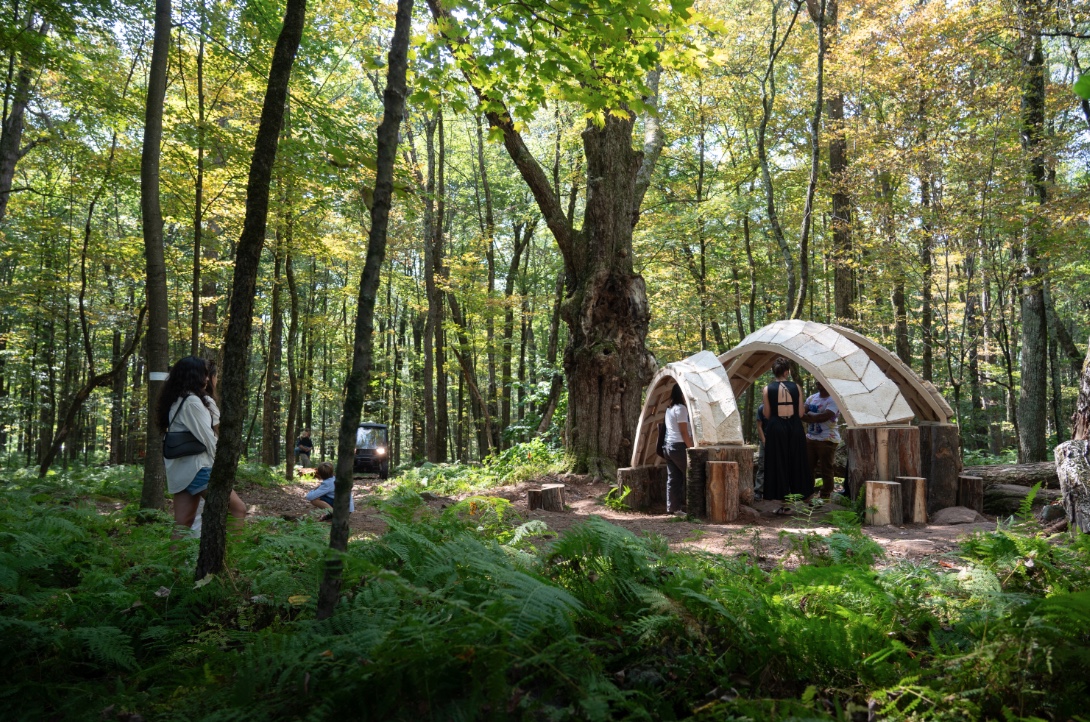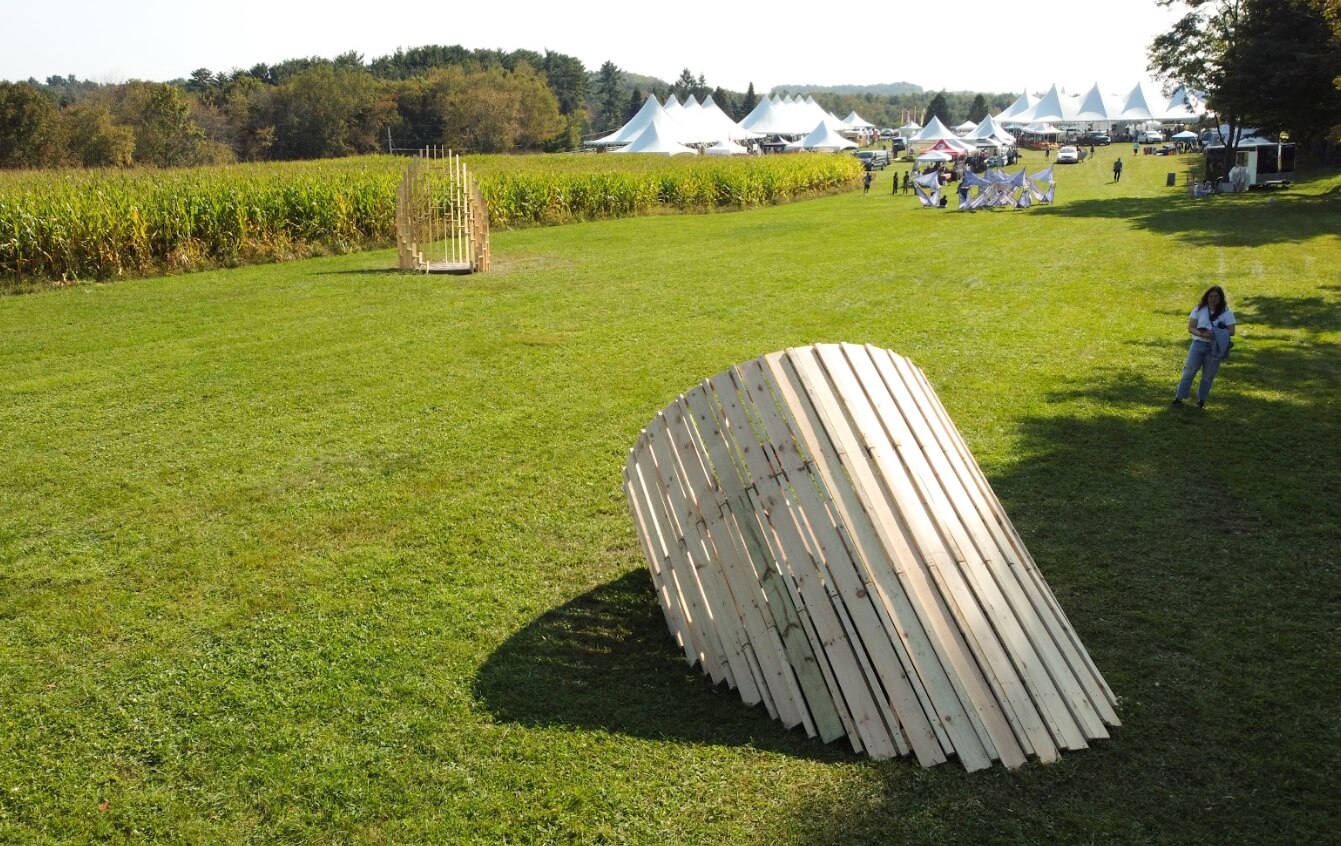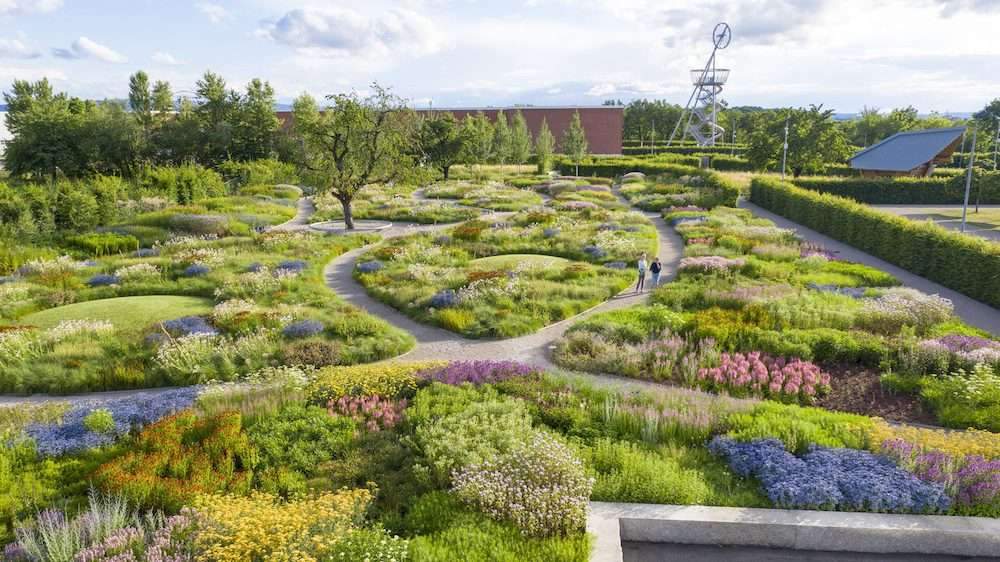Now in its third iteration, Bethel Woods Art and Architecture Festival wrapped up this month. In Bethel, New York, architecture students, professors, and organizers put together a sprawling group show spread throughout the historic site of the 1969 Woodstock festival.
The affair took place between September 11 and 15. Students and faculty from Princeton University, Kean University, Auburn University, Syracuse University, Cornell University, Arizona State University, Georgia Tech, Rensselaer Polytechnic Institute, and Rochester Institute of Technology all partook.
Build Community, Build Creatively, Build Fest was this year’s theme. Over the course of five days, participants built installations they designed off-site in the months leading up to BuildFest. The installations will be on view during Catbird Music Festival as functional art infrastructures, much like the designs by University of Miami students and professors at Woodstock 55 years ago.
“Buildings are, at their core, physical constructs,” festival organizer Neal Lucas Hitch said in a statement. “Even with the rise of computational design tools and digital fabrication, they are still, necessarily, grounded in the material world; for every robot that mills or prints an object, there are people who move and transport those objects. Likewise, festivals are physical interactions between people–one of the remaining few places where groups gather to interface and collaborate socially without a digital veil.”
Hitch continued: “With this understanding, BuildFest approaches the dichotomy between the physical and digital not as a binary but as a chance for collaboration—asking participants to imagine what a future might look like in which digital and analog methods of construction are integrated in a more wholesome manner; one in which building technologies (old and new) can fuse to foster smaller, greener and more diverse economies capable of sustaining the long-term habitation of humans on this great floating mud-ball, planet earth.”
The seven projects presented at this year’s festival are listed below with descriptions provided by the project teams.

Timberlyn
Princeton University
“Timberlyn is inspired by the historic spirit of Woodstock and epitomizes the synergy between human ingenuity and robotic precision. Crafted from the collaboration between humans and robots, this eco-conscious stage offers versatility, accommodating music performances and community events alike. The project utilizes state-of-the-art research in human-robot collaborative construction (HRCC), leveraging sustainable practices to design and fabricate a versatile structure from reclaimed dimensional lumber. In the HRCC process, humans and robots combine their respective advantages—the dexterity and decision-making capabilities of humans and the precision and efficiency of robots—in a shared assembly environment. The assembly workflow is enhanced through real-time perception feedback and adaptive control optimization, enabling waste minimization for bespoke construction and advancing current practices toward sustainable automation.”

Curtain Call
Auburn, Syracuse, & Cornell Universities
“Curtain Call investigates the use of semi-automated construction methods to test the formal, spatial, and structural capacity of light wood framing. Semi-automated construction is a hybrid method that emphasizes human-robot collaboration. Rather than robotically automating the process entirely, this method allows human participants at all skill levels to easily engage in the construction process. Ultimately, this project considers alternate approaches that expand conventional modes of labor relative to the design, fabrication, and construction process. More than just a shade structure, the project provides a highly flexible “stage” that allows for a wide range of programming. It can accommodate informal, impromptu activities such as lounging, picnicking, or reading, or organized festival activities such as movie nights, lectures, pop-ups, and performances of all kinds.”

Rise, Repeat
Georgia Tech & Rensselaer Polytechnic Institute
“The pavilion makes use of three off-the-shelf elements commonplace in everyday American domestic construction: (1) pressure-treated, pine stair stringers, (2) precast concrete deck footings, and (3) stainless-steel, star-drive deck screws. The repetition of uniform, pre-fabricated elements allows for an economical budget and ease/speed of assembly in the field. Stringer elements are joined mechanically with screws, without the need to cut or modify the elements and without using adhesives or coatings. This light-touch construction method allows for a strategy of disassembly and re-use, considering the full life cycle of the pavilion’s materials. After the three-year installation at Bethel Woods, the pavilion can be dismantled and relocated to another site or dismantled and donated to community building organizations in the area to be re-used as gently-used stair stringers in conventional construction. In this way, the project serves as a modest testing ground for a reusable, circular approach to architecture and its materials.”

MycoShell
Cornell University
“MycoShell is an installation that exhibits the potential of biological self-growing and adaptive building materials toward a collaborative future of the digital and the analog. MycoShell is constructed of structural mycelium-bound composite panels that have been grown from a local fungal strain of the Ganoderma family on regional agricultural byproducts of corn and hemp. The result is a biobased, carbon-negative, and fully circular building component with structural capacities. MycoShell engages these mycelium-bound panels to form a compression-optimized vault built from individual catenary arches.”

Blocks
Kean University
“Blocks is a modular furniture series designed to create an interactive and playful seating area for the Harvest Festival. Comprised of three components: an L-shaped bench, an L-shaped 6 step, and movable cubes, the project creates an engaging landscape that charges the user with defining its boundaries. The benches and steps are spread across the area to create different interaction zones, while the movable cubes can be stacked, moved, rotated, and shifted for individual needs. The movable cubes are clad on two sides with an alternating system of wood tiles and custom HDPE tiles. The HDPE tie-dye tiles are made from recycled HDPE plastic and cast in custom CNC-milled molds. This modular seating creates an engaging and versatile environment for all Harvest Festival visitors.”

Spring/Summer 2024
Arizona State University
“Spring/Summer 24 intertwines the vibrant essence of Woodstock fashion with cutting-edge architectural practices. It serves as an homage to the freedom, rebellion, and connection to nature emblematic of Woodstock’s iconic style while pioneering the utilization of textiles as a primary architectural element. The proposal celebrates the versatility of textiles, drawing inspiration directly from the diverse array of materials, patterns, and styles that defined the clothing of the Woodstock generation. By embracing textiles as the fundamental building block, our installation transcends conventional architectural norms, mirroring the boundary-defying spirit of Woodstock.”

The Pen
Rochester Institute of Technology
“The Pen is a 36-sided tridecahexagonal cylinder made from recycled materials, emerging from the ground as a multifaceted sculptural form. The structure serves as a submerged seating area, inviting engagement from visitors while visually aligning with a second adjacent 36-sided platform across the field. The distant deck functions as a stage, creating a dynamic interplay between the two elements. Together, these geometric forms redefine the landscape, offering a space for gathering, performance, and reflection, all within an environmentally conscious framework that reuses discarded materials.”


